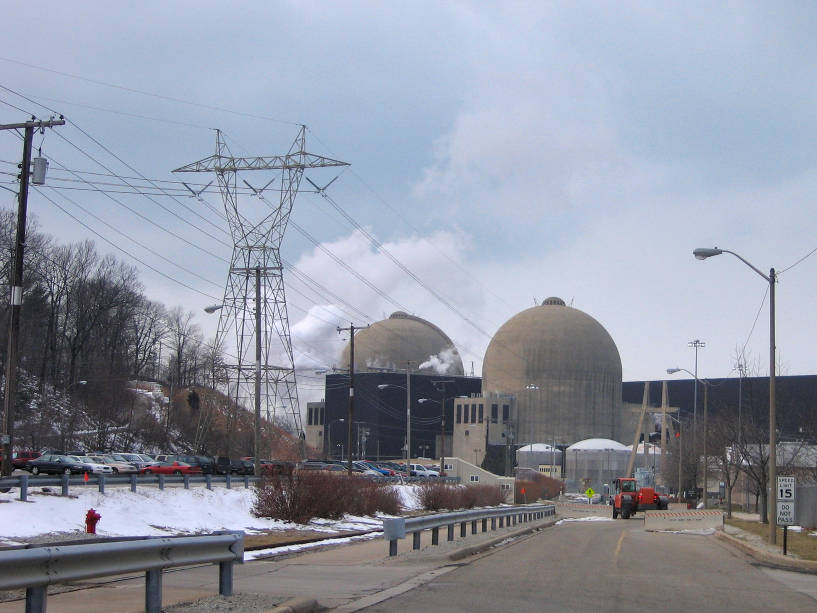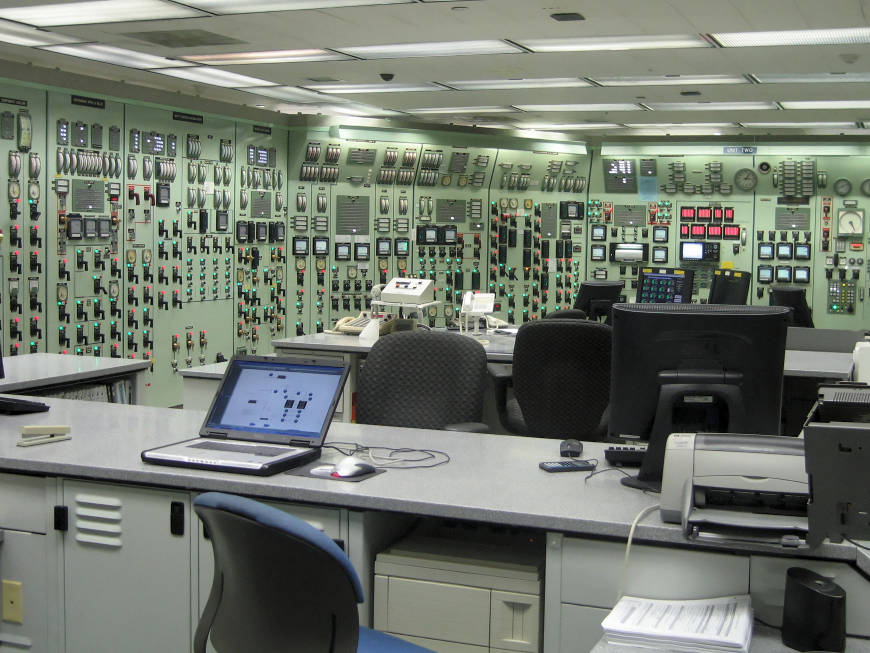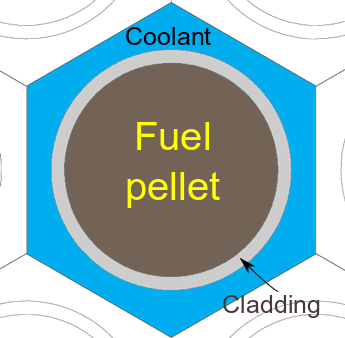What is a nuclear reactor?
By Nick Touran, Ph.D., P.E., , Reading time: 15 minutes
 A nuclear reactor is a system that
contains and controls sustained nuclear chain reactions. Reactors are used for
generating electricity, moving aircraft carriers and submarines, producing
medical isotopes for imaging and cancer treatment, and for conducting research.
A nuclear reactor is a system that
contains and controls sustained nuclear chain reactions. Reactors are used for
generating electricity, moving aircraft carriers and submarines, producing
medical isotopes for imaging and cancer treatment, and for conducting research.
Fuel, made up of heavy atoms that split when they absorb neutrons, is placed into the reactor vessel (basically a large tank) along with a small neutron source. The neutrons start a chain reaction where each atom that splits releases more neutrons that cause other atoms to split. Each time an atom splits, it releases large amounts of energy in the form of heat. The heat is carried out of the reactor by coolant, which is most commonly just plain water. The coolant heats up and goes off to a turbine to spin a generator or drive shaft. Nuclear reactors are just exotic heat sources.
On this page
Main components
-
The core of the reactor contains all of the nuclear fuel and generates all of the heat. It contains low-enriched uranium (<5% U-235), control systems, and structural materials. The core can contain hundreds of thousands of individual fuel pins.
-
The coolant is the material that passes through the core, transferring the heat from the fuel to a turbine. It could be water, heavy-water, liquid sodium, helium, or something else. In the US fleet of power reactors, water is the standard.
-
The turbine transfers the heat from the coolant to electricity, just like in a fossil-fuel plant.
-
The containment is the structure that separates the reactor from the environment. These are usually dome-shaped, made of high-density, steel-reinforced concrete. Chernobyl did not have a containment to speak of.
-
Cooling towers are needed by some plants to dump the excess heat that cannot be converted to energy due to the laws of thermodynamics. These are the hyperbolic icons of nuclear energy. They emit only clean water vapor.
The control room

Animated reactor system
The animation above (reproduced from the NRC) shows a nuclear reactor heating up water and whirling a generator to produce electricity. It captures the essence of the system well. The water coming into the condenser and then going right back out is water from a river, lake, or ocean. It goes out the cooling towers. As you can see, this water does not go near the radioactivity, which is in the reactor vessel.
Fuel pins
 The smallest unit of the reactor is the fuel pin. These are typically uranium-oxide (UO2),
but can take on other forms, including thorium-bearing material.
They are often surrounded by a metal tube (called the cladding) to keep fission products from escaping
into the coolant.
The smallest unit of the reactor is the fuel pin. These are typically uranium-oxide (UO2),
but can take on other forms, including thorium-bearing material.
They are often surrounded by a metal tube (called the cladding) to keep fission products from escaping
into the coolant.
Fuel assembly
 Fuel assemblies are bundles of fuel pins. Fuel is put in and taken out of the reactor in assemblies.
The assemblies have some structural material to keep the pins close but not touching,
so that there’s room for coolant.
Fuel assemblies are bundles of fuel pins. Fuel is put in and taken out of the reactor in assemblies.
The assemblies have some structural material to keep the pins close but not touching,
so that there’s room for coolant.
Full core
 This is a full core, made up of several hundred assemblies. Some assemblies are control assemblies.
Various fuel assemblies around the core have different fuel in them. They vary in enrichment
and age, among other parameters. The assemblies may also vary with height, with different enrichments
at the top of the core from those at the bottom.
This is a full core, made up of several hundred assemblies. Some assemblies are control assemblies.
Various fuel assemblies around the core have different fuel in them. They vary in enrichment
and age, among other parameters. The assemblies may also vary with height, with different enrichments
at the top of the core from those at the bottom.
Types of Reactors
There are many different kinds of nuclear fuel forms, moderators, and cooling materials can be used in a nuclear reactor. As a result, there are thousands of different possible nuclear reactor designs. Here, we discuss a few of the designs that have been built before, but don’t limit your imagination; over a million other reactor designs are possible. Dream up your own! Or, for fun you can try our Random Reactor Concept Generator or see a list of over a million options.
A incomplete subset of reactor types broken down by coolant and moderator is shown below. For simplicity, we limit it to reactors that have either been built, are under construction, or have been the subject of significant experimentation and/or study. Reactors concepts in all boxes have been proposed.
|
Water | Heavy water | Graphite | Not moderated | Beryllium/BeO | Organic | Hydrogen / Hydride | ||
|---|---|---|---|---|---|---|---|---|---|
| Water |
Light-water reactors (LWR) |
|
Steam-cooled fast reactors1 |
||||||
| Heavy water |
|
||||||||
| Molten mercury metal |
|
||||||||
| Molten sodium metal |
Sodium-Deuterium Reactor1 |
Sodium-Graphite Reactors (SGR) |
Sodium-cooled fast reactors (SFR) |
Sodium-Beryllium Reactors |
|||||
| Molten lead metal |
Lead-cooled fast reactors |
||||||||
| Molten salt |
Fast MSR
|
||||||||
| CO2 |
Heavy Water Gas Cooled Reactors (HWGCR)
|
Gas-Graphite reactors
|
|||||||
| Air |
|
Low-power fast reactor experiments, like ZPPR |
|
||||||
| Helium |
Helium-cooled fast reactors1 |
||||||||
| Nitrogen | |||||||||
| Organic (e.g. terphenyl) |
Organic moderated reactors (OMR) |
||||||||
| Liquid Hydrogen |
Nuclear Thermal Rockets |
- Proposed and studied, but never built.
- The ARE had sodium metal coolant in the reflector but was primarily molten salt cooled.
- The Alfa-class submarines are fairly unknown, but had sufficient Be to consider them moderated reactors, not fast.
- Constructed but never fueled or operated
Another view of the options is shown below:
graph TD
TRL([Choose\ntechnology\nreadiness\nlevel]) --> High --> Construction
TRL --> MedT[Medium] --> Construction
TRL --> Low --> Construction
Construction([Choose\nconstruction\nstyle]) --> Modular --> Size
Construction --> Stick --> Size
Size([Choose\nsize]) --> Micro --> Cycle
Size --> Small --> Cycle
Size --> Medium --> Cycle
Size --> Large --> Cycle
Size --> Gargantuan --> Cycle
Cycle([Choose\npower cycle]) --> Rankine --> Moderator
Cycle --> Brayton -->Moderator
Cycle --> Stirling -->Moderator
Cycle --> Piston --> Moderator
Cycle --> Chemical --> Moderator
Cycle --> Thermionic --> Moderator
Cycle --> Ion[Ion capture] --> Moderator
Cycle --> Inturbine[In-\nturbine\ncombustion] --> Moderator
Cycle --> Other --> Moderator
Moderator([Choose\nmoderator]) --> MWater[Water] --> FFM
Moderator --> MHW[Heavy Water] --> FFM
Moderator --> None --> FFM
Moderator --> Graphite --> FFM
Moderator --> Beryllium --> FFM
Moderator --> MOrganic[Organic] --> FFM
Moderator --> Hydride --> FFM
FFM([Choose\nfuel\nform]) --> Oxide --> FC
FFM --> Metal --> FC
FFM --> Nitride --> FC
FFM --> Carbide --> FC
FFM --> TRISO --> FC
FFM --> MSF[Molten salt] --> FC
FFM --> LMF[Liquid metal] --> FC
FC([Choose\nfuel\ncycle]) --> LEU[LEU converter] --> Coolant
FC --> NU[Natural uranium\nconverter] --> Coolant
FC --> HALEU[HALEU converter] --> Coolant
FC --> HEU[HEU burner] --> Coolant
FC --> PU[Plutonium burner] --> Coolant
FC --> UPU[U-Pu breeder] --> Coolant
FC --> THU[Th-U breeder] --> Coolant
Coolant([Choose\ncoolant]) --> Gas --> CO2
Gas --> Nitrogen
Gas --> He
Gas --> Air
Coolant --> Water --> LW["Light\nwater"] --> BWR
LW --> PWR
LW --> Steam
Water --> HW["Heavy\nwater"]
Coolant --> LM[Liquid Metal] --> Na["Sodium/\nNaK"]
LM --> Lead["Lead/\nPbBi"]
LM --> Mercury
Coolant --> Salt["Molten\nSalt"]
Salt --> Fluoride
Salt --> Chloride
Coolant --> Organic
Coolant --> Sulfur
Coolant --> LH["Liquid\nHydrogen"]
Coolant --> HP["Heat\nPipe"]
Coolant --> OTH["Other\n(Sulfate,\nplasma,\ndust)"]
Pressurized Water Reactor
The most common type of reactor. The PWR uses regular old water as a coolant. The primary cooling water is kept at very high pressure so it does not boil. It goes through a heat exchanger, transferring heat to a secondary coolant loop, which then spins the turbine. These use oxide fuel pellets stacked in zirconium tubes. They could possibly burn thorium or plutonium fuel as well.
Pros:
-
Strong negative void coefficient — reactor cools down if water starts bubbling because the coolant is the moderator, which is required to sustain the chain reaction
-
Secondary loop keeps radioactive stuff away from turbines, making maintenance easy.
-
Very much operating experience has been accumulated and the designs and procedures have been largely optimized.
Cons:
- Pressurized coolant escapes rapidly if a pipe breaks, necessitating lots of back-up cooling systems.
- Can’t breed new fuel — susceptible to "uranium shortage"
Boiling Water Reactor
Second most common, the BWR is similar to the PWR in many ways. However, they only have one coolant loop. The hot nuclear fuel boils water as it goes out the top of the reactor, where the steam heads over to the turbine to spin it.
Pros:
- Simpler plumbing reduces costs
- Power levels can be increased simply by speeding up the jet pumps, giving less boiled water and more moderation. Thus, load-following is simple and easy.
- Very much operating experience has been accumulated and the designs and procedures have been largely optimized.
Cons:
- With liquid and gaseous water in the system, many weird transients are possible, making safety analysis difficult
- Primary coolant is in direct contact with turbines, so if a fuel rod had a leak, radioactive material could be placed on the turbine. This complicates maintenance as the staff must be dressed for radioactive environments.
- Can’t breed new fuel — susceptible to “uranium shortage”
- Does not typically perform well in station blackout events, as in the Fukushima Daiichi accident.
Canada Deuterium-Uranium Reactors (CANDU)
CANDUs are a Canadian design found in Canada and around the world. They contain heavy water, where the Hydrogen in H2O has an extra neutron (making it Deuterium instead of Hydrogen). Deuterium absorbs many fewer neutrons than Hydrogen, and CANDUs can operate using only natural uranium instead of enriched.
Pros:
- Require very little uranium enrichment.
- Can be refueled while operating, keeping capacity factors high (as long as the fuel handling machines don’t break).
- Are very flexible, and can use any type of fuel.
Cons
- Some variants have positive coolant temperature coefficients, leading to safety concerns.
- Neutron absorption in deuterium leads to tritium production, which is radioactive and often leaks in small quantities.
- Can theoretically be modified to produce weapons-grade plutonium slightly faster than conventional reactors could be.
See Also
- CANTEACH — The most comprehensive public domain educational and reference library on CANDU technology.
Sodium Cooled Fast Reactor
These reactors are cooled by liquid sodium metal. Sodium is heavier than hydrogen, a fact that leads to the neutrons moving around at higher speeds (hence fast). These can use metal or oxide fuel, and burn a wide variety of fuels.
Pros:
- Can breed its own fuel, effectively eliminating any concerns about uranium shortages (see what is a fast reactor?)
- Can burn its own waste
- Metallic fuel and excellent thermal properties of sodium allow for passively safe operation — the reactor will shut itself down safely without any backup-systems working (or people around), only relying on physics.
Cons:
- Sodium coolant is reactive with air and water. Thus, leaks in the pipes results in sodium fires. These can be engineered around but are a major setback for these reactors.
- To fully burn waste, these require reprocessing facilities which can also be used for nuclear proliferation.
- The excess neutrons used to give the reactor its resource-utilization capabilities could clandestinely be used to make plutonium for weapons.
- Positive void coefficients are inherent to most fast reactors, especially large ones. This is a safety concern.
- Not as much operating experience has been accumulated. We have only about 300 reactor-years of experience with sodium cooled reactors.
Molten Salt Reactor
Update! There is now a full page discussing MSRs in detail. Molten Salt Reactor’s (MSRs) are the internet’s favorite reactor. They are unique so far in that they use fluid fuel.
Pros:
- Can constantly breed new fuel, eliminating concerns over energy resources
- Can make excellent use of thorium, an alternative nuclear fuel to uranium
- Can be maintained online with chemical fission product removal, eliminating the need to shut down during refueling.
- No cladding means less neutron-absorbing material in the core, which leads to better neutron efficiency and thus higher fuel utilization
- Liquid fuel also means that structural dose does not limit the life of the fuel, allowing the reactor to extract very much energy out of the loaded fuel.
Cons:
-
Radioactive gaseous fission products are not contained in small pins, as they are in typical reactors. So if there is a containment breach, all the fission gases can release instead of just the gases from one tiny pin. This necessitates things like triple-redundant containments, etc. and can be handled.
-
The presence of an online reprocessing facility with incoming pre-melted fuel is a proliferation concern. The operator could divert Pa-233 to provide a small stream of nearly pure weapons-grade U-233. Also, the entire uranium inventory can be separated without much effort. In his autobiography, Alvin Weinberg explains how this was done at Oak Ridge National Lab: “It was a remarkable feat! In only 4 days all of the 218 kg of uranium in the reactor were separated from the intensely radioactive fission products and its radioactivity reduced five billion-fold.”
-
Very little operating experience, though a successful test reactor was operated in the 1960s
High Temperature Gas Cooled Reactor
HTGRs use little pellets of fuel backed into either hexagonal compacts or into larger pebbles (in the prismatic and pebble-bed designs). Gas such as helium or carbon dioxide is passed through the reactor rapidly to cool it. Due to their low power density, these reactors are seen as promising for using nuclear energy outside of electricity: in transportation, in industry, and in residential regimes. They are not particularly good at just producing electricity.
Pros:
- Can operate at very high temperatures, leading to great thermal efficiency (near 50%!) and the ability to create process heat for things like oil refineries, water desalination plants, hydrogen fuel cell production, and much more.
- Each little pebble of fuel has its own containment structure, adding yet another barrier between radioactive material and the environment.
Cons:
- High temperature has a bad side too. Materials that can stay structurally sound in high temperatures and with many neutrons flying through them are hard to come by.
- If the gas stops flowing, the reactor heats up very quickly. Backup cooling systems are necessary.
- Gas is a poor coolant, necessitating large amounts of coolant for relatively small amounts of power. Therefore, these reactors must be very large to produce power at the rate of other reactors.
- Not as much operating experience